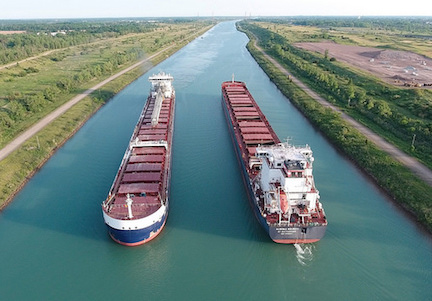The following is text of a news release from the Chamber of Marine Commerce:
(OTTAWA) — As the St. Lawrence Seaway officially opened for business Tuesday, U.S. Great Lakes ports are predicting the shipping season will mirror last year’s stellar performance.
In 2018, many U.S. Great Lakes ports recorded their highest cargo totals in recent years, with strong volumes of iron ore, petroleum products, construction products and international grain exports. This coming season, road salt shipments should also be strong as cities replenish their reserves after a long, difficult winter.
“We are optimistic these trends will continue into the new season and off-season investments made by the St. Lawrence Seaway and local ports will make 2019 another great season for our members,” said Bruce Burrows, president of the Chamber of Marine Commerce. ”To shore up the economic strength of the bi-national Great Lakes-St. Lawrence region, we would also urge the U.S. government to drop steel and aluminum steel tariffs on Canadian imports and return to a fair and free trade environment between our two countries.”
In 2018, the Port of Duluth-Superior handled a total of 32.6 million metric tons of cargo, its highest mark since 2014. Iron ore tonnage outpaced the five-year average by more than 30 percent. In fact, the 19.5 million metric tons was the most shipped out of Duluth-Superior in a single season since 1995. Grain exports also posted a 23 percent year-over-year increase. That combination, in addition to the continued development and expansion of the Duluth Seaway Port Authority’s multimodal terminal, helped propel the 2018 tonnage increase.
“Manufacturing and steelmaking sectors are still looking strong for 2019, as all six taconite facilities on Minnesota’s Iron Range are operating at full capacity,” said Jayson Hron, director of communications and marketing, Duluth-Seaway Port Authority. “We hope the strong pace of grain exports continues well into 2019 and we anticipate a continued brisk pace for the movement of project cargo in and out of the heartland via the Great Lakes-St. Lawrence Seaway System.”
The Port of Green Bay moved more than 2 million tons of cargo in 2018, the first time the port has reached that mark since 2013. Green Bay saw a 14 percent increase in cargo over 2017 due to increased foreign imports of petroleum products by 528 percent and a 230 percent increase in limestone. Port Director Dean Haen predicted the significant increases in petroleum products will continue again in 2019 due to the closure of the petroleum pipeline to northeast Wisconsin.
The Port of Toledo handled more overseas vessels in 2018 than any year since 2006. The increase was due to robust grain exports balanced by imported project cargo and aggregates. Overall, the port finished 2.3 percent ahead of 2017 with the largest increases in grain and dry bulk.
“Project cargo shipments will continue in 2019 in support of the construction of the Cleveland-Cliffs Toledo hot briquetted iron production facility and other large-scale projects in the region,” said Joe Cappel, vice president of business development for the Toledo-Lucas County Port Authority. “Terminals are reporting that they expect 2019 tonnage results to be very similar to 2018. We could expect aluminum and steel shipments from Canada to rebound should the import tariff on these goods be reduced or eliminated. As we continue to modernize and upgrade our facilities and capabilities, we are optimistic that 2019 will be a good year for the Port of Toledo.”
In 2018, Port Milwaukee international tonnage increased 30 percent compared to 2017, totaling 460,000 metric tons, due in part to the refurbishment of its liquid cargo pier and expanded barge and tanker activity.
“Thanks to the port’s winter accessibility to shipping, Port Milwaukee is already 16 percent higher in year-to-date tonnage compared to February 2018, having received almost 250,000 tons of salt,” said Adam Schlicht, Port Milwaukee director. “This year, the port anticipates more than 10 cruise ship visits, a threefold increase from previous years. Milwaukee will soon be a premiere turnaround port for Great Lakes cruise itineraries and passengers seeking immediate access to visitor-friendly, downtown experiences.”

